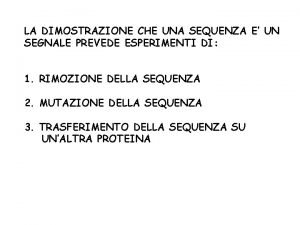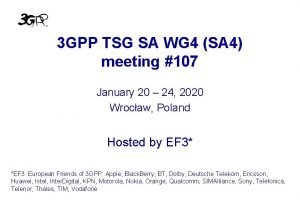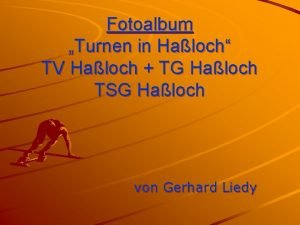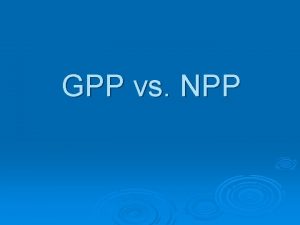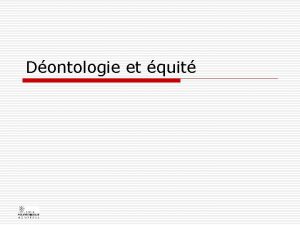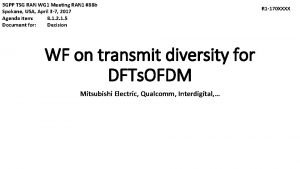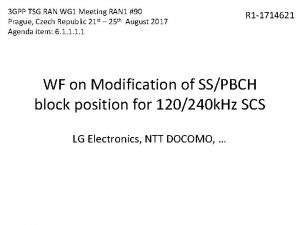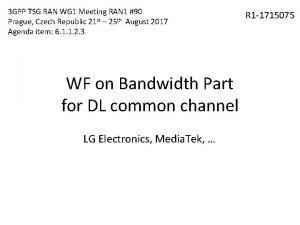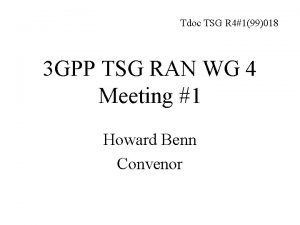3 GPP TSG RAN WG 1 Meeting 90





- Slides: 5

3 GPP TSG RAN WG 1 Meeting #90 17 xxxxx Prague, Czech Republic, 21 -25 August, 2017 Agenda item: 6. 1. 3. 4 Way Forward on NR Carrier Aggregation Huawei, Hi. Silicon, Nokia Shanghai Bell R 1 -

Background(1) Agreements: • On the search space: – A UE monitors PDCCH candidates in common search space(s) at least for RMSI and UE specific search space(s) on Primary Component Carrier (PCC) – A UE monitors PDCCH candidates at least on UE-specific search space(s) for an Secondary Component Carrier (SCC) • Support cross carrier scheduling with CIF – – – NR at least support that a carrier is scheduled by one and only one carrier FFS: the number of CIF bits FFS: BWP aspects for cross carrier scheduling • For cross-carrier scheduling, PDCCH and the scheduled PDSCH can have the same or different numerologies. • For self-scheduling, PDCCH and the scheduled PDSCH have the same numerology – FFS whether for self-scheduling, PDCCH and the scheduled PDSCH can have different numerologies. • For self and cross-carrier scheduling, PDCCH and the scheduled PUSCH can have the same or different numerologies. • When numerology are different between PDCCH and the scheduled transmission, the time granularity indicated in the DCI for the timing relationship between the end of PDCCH and the corresponding scheduled transmission is based on the numerology of the scheduled transmission.

Background(2) • For multiple timing advance groups – – – LTE timing difference requirement can be used as a starting point FFS factors related to this requirement. Support PRACH transmission for timing advance acquisition on SCC • NR Supports 2 cell groups for PUCCH for NR DC – FFS: NR supports 2 cell groups for PUCCH for NR CA Working assumptions • HARQ-ACK transmission related to multiple DL component carriers is supported for DL component carriers operating with the same and different numerology – The time granularity of a HARQ-ACK transmission on PUCCH, indicated in the DCI scheduling the PDSCH, is based on the numerology of PUCCH transmission.

Proposal (1) • HARQ-ACK transmission related to multiple DL component carriers is supported for DL component carriers operating with the same and different numerology − The time granularity of a HARQ-ACK transmission on PUCCH, indicated in the DCI scheduling the PDSCH, is based on the numerology of PUCCH transmission. • For cross-carrier scheduling, support the following functionalities − Multi-slot scheduling

Proposal (2) • For NR CA, at least for the scenario that all the carriers are 15 Khz, 32. 47 us maximum uplink timing difference between two TAGs should be assumed in NR. − FFS the TA granularity is predefined according to the numerology of each carrier. − FFS the carriers in each TAG have the same numerology. − FFS other scenarios − FFS whether the maximum number of TAG is relevant or irrelevant with the maximum timing difference among carriers. − FFS whether the maximum number of TAG is relevant or irrelevant with numerology. − FFS the scenario that multiple BWP with different numerologies are configured in the same carrier • For NR CA, both semi-static and dynamic HARQ-ACK codebook are supported − Dynamic HARQ-ACK codebook determination is based on C-DAI and T-DAI − Dynamic HARQ-ACK codebook determination shall consider at least multi-slot scheduling, CBG based feedback and carrier aggregation with different numerologies. • NR supports 2 cell groups for PUCCH for NR CA − NR supports at least the configuration of one carrier transmitting the PUCCH within the cell group − FFS The carrier transmitting the PUCCH is always PCC and/or carrier(s) transmitting the PUCCH can be SCC in a cell group containing PCC
